The mighty mountain of Huangshan is another of the five sacred mountains like Tai Shan (see previous blog) created by the disintegrating body of Pan Gu. It is famed for its beauty and rightly so, for the views from the summit area are spectacular. The granite peaks of the mountain jut into the sky like dog’s teeth, forming a jagged terrain that has steep ascents and descents between them. When the clouds roll in or the mist thickens to fog, the peaks appear to stand like islands rising from a milky, swirling sea. From the idyllic views, legions of poets and painters have drawn inspiration making Huangshan one of the most historically documented sites in China.
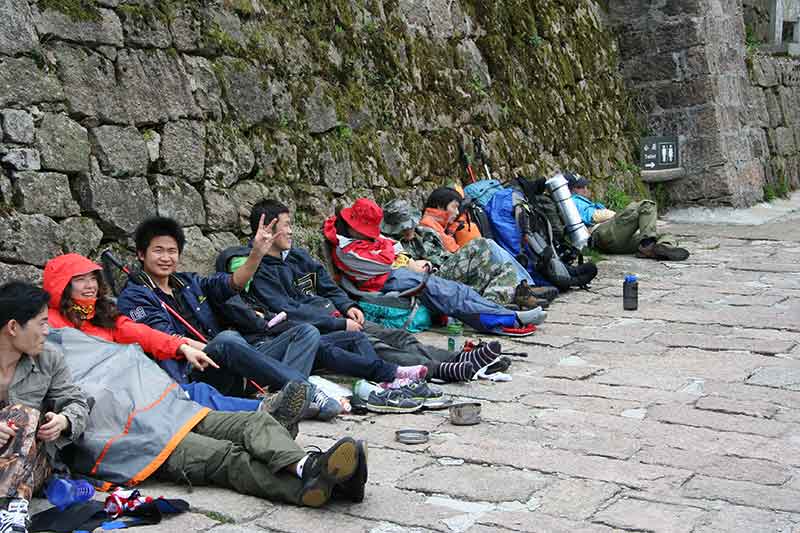 Our trip to the idyllic views of this iconic mountain had a distinctly sweet and sour taste to it and I’m going to get the sour part off my chest first! It turned out, because I had planned our journey through China by day numbers rather than dates (so as to maximise our visa), that we were to climb Huang Shan over the Chinese May Bank Holiday. All the accommodation was full so, obviously, we booked ourselves on to a tour. We were pleasantly surprised by the price but, subsequent events, proved the maxim that you get what you pay for. First off, we were on a Chinese tour, with Chinese guides who had no English and, of the 50 odd trippers, we stood out as the only foreigners. The guides carried microphones attached to loudspeakers strung around their waists through which they shouted information or barked orders. They wore the communication equipment like a badge of rank, bestowing them a status that enabled them to queue jump and generally exempt themselves from the rules and protocols that confined mere mortals. I even caught two of them talking between themselves, standing side by side, shouting through their megaphones. It wouldn’t surprise me if they slept in their special equipment.
Our trip to the idyllic views of this iconic mountain had a distinctly sweet and sour taste to it and I’m going to get the sour part off my chest first! It turned out, because I had planned our journey through China by day numbers rather than dates (so as to maximise our visa), that we were to climb Huang Shan over the Chinese May Bank Holiday. All the accommodation was full so, obviously, we booked ourselves on to a tour. We were pleasantly surprised by the price but, subsequent events, proved the maxim that you get what you pay for. First off, we were on a Chinese tour, with Chinese guides who had no English and, of the 50 odd trippers, we stood out as the only foreigners. The guides carried microphones attached to loudspeakers strung around their waists through which they shouted information or barked orders. They wore the communication equipment like a badge of rank, bestowing them a status that enabled them to queue jump and generally exempt themselves from the rules and protocols that confined mere mortals. I even caught two of them talking between themselves, standing side by side, shouting through their megaphones. It wouldn’t surprise me if they slept in their special equipment.
As the guides could not speak English and, as they always performed a roll call whenever we got on or off the bus, we became known by the number that we appeared on the list of passengers: ‘Number fiferteen?’ They would shout. And we felt like we had been reduced to a number as we were herded like prisoners around the sites.
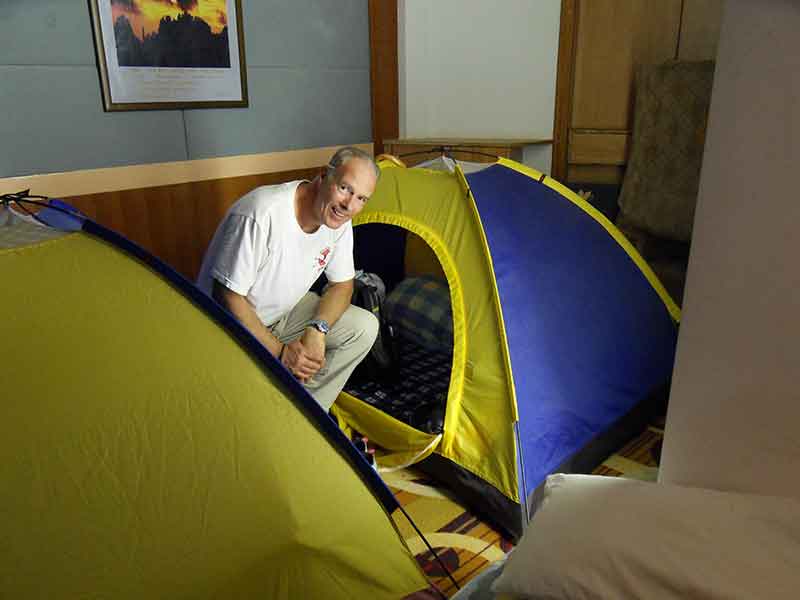 However, it was the accommodation that was the worst part of the tour. The first night, we had a dirty room with an ensuite bathroom without hot water, towels, soap or toilet paper. Not the end of the world, since we carry towels, soap and toilet paper. But the bigger issue was that the bed sheets were soiled and the pillows encrusted with other people’s excretions. If we thought that was bad, the second night we were led into the banqueting room of a hotel on the top of Huangshan. The room had one wall lined with twenty two man tents and the central area piled with bunk beds in rows three or four deep. There must have been about 200 people sleeping in the room and I have never slept with so many people since last travelling Virgin Dormitory (business) Class. We had a tent. The zip failed so that the privacy of the flap became useless, it was too short for me to stretch out my tired legs, It had bed bugs, a duvet/blanket sort of thing that was dirty enough to climb the mountain by itself and a ‘pillow’ whose support had been crushed from it and now had mould decomposing what remained. Us, and our new best friends, had two squatter toilets to share. You had to be either brave or desperate (or both).
However, it was the accommodation that was the worst part of the tour. The first night, we had a dirty room with an ensuite bathroom without hot water, towels, soap or toilet paper. Not the end of the world, since we carry towels, soap and toilet paper. But the bigger issue was that the bed sheets were soiled and the pillows encrusted with other people’s excretions. If we thought that was bad, the second night we were led into the banqueting room of a hotel on the top of Huangshan. The room had one wall lined with twenty two man tents and the central area piled with bunk beds in rows three or four deep. There must have been about 200 people sleeping in the room and I have never slept with so many people since last travelling Virgin Dormitory (business) Class. We had a tent. The zip failed so that the privacy of the flap became useless, it was too short for me to stretch out my tired legs, It had bed bugs, a duvet/blanket sort of thing that was dirty enough to climb the mountain by itself and a ‘pillow’ whose support had been crushed from it and now had mould decomposing what remained. Us, and our new best friends, had two squatter toilets to share. You had to be either brave or desperate (or both).
And the noise was incredible, the snoring was of epic proportions; it was as if there was a competition as to whom could make the most noise for the longest time. The cacophony was punctuated by the sound of mobiles going off. I can tell you from bitter experience that the Chinese do not talk on a mobile phone, they shout. They seem very keen to share the details of their conversation not just with the other 200 people in the room but also with everyone else on the mountain. Personally, I wouldn’t want to do that, especially at night. But that’s just me. We had to be up at 3:30 in the morning and it is not often that I am awake and away with such enthusiasm at such an hour. But we were lucky: we could have been given one of the hundreds of tents erected outside the hotel on concrete slabs and subject to the freezing nighttime temperatures.
Finally, the hordes of Chinese don’t help the crowded situation on and around the mountain. In China, the instinct of large numbers of people with a common goal is to from a huge surging mass. It’s everyone for themselves, no quarter is given and the devil take the hindmost. The Chinese have no sense of personal space. Any advantage, however small, is sought and fought for using any means other than open violence. We simply hope we don’t get killed in the rush. And they won’t wait for anyone to leave an area before they try to force their way in. So, getting off a crowded metro when the waiting masses want to get on becomes a struggle of my considerably weighty bulk (aided by the dainty slip of my wife) against the massed ranks of commuters. We often get unkind words hurled in our direction by the indignant indigenous.
But, if you are wondering how this affects trekking Huangshan, then imagine the chaos that can be caused by people stopping for rests, photographs, exhaustion or chats on a crowded mountain where not every steep sided pathway is railed for safety. Its start, stop, push, shove with no sense of decorum. When I want to take a photo of my beloved posing like a statuesque model with the stunningly wonderful backdrop that the mountain provides, everyone walks in front of the camera. Some even stop in front of me to take their own snaps and some might even use the space to stop for a chat with their mates.
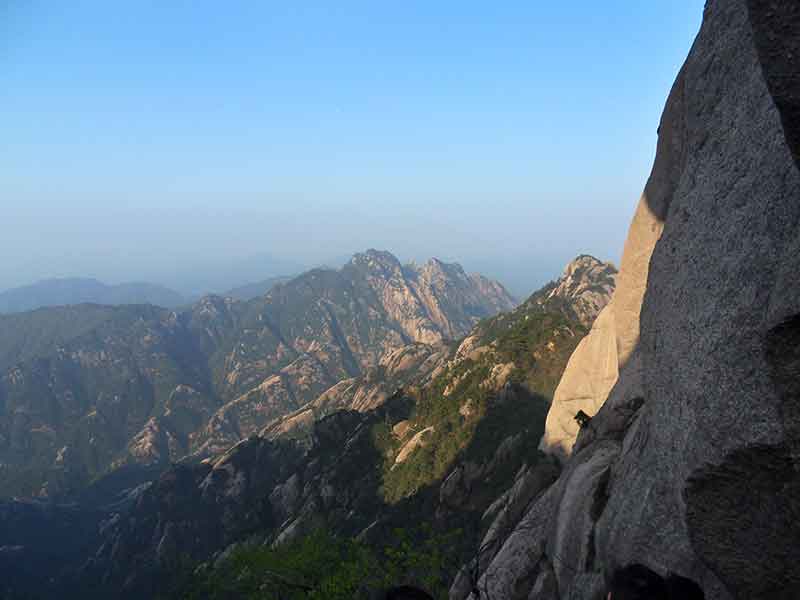 But if you have got the impression that it was not fun, you would be mistaken. Once on top of the mountain, we managed to break away from the group and spent the rest of the day by ourselves, seeking out the areas far from the madding crowd. With staggering views and glorious names such as ‘Beginning to Believe Peak’ and ‘Flying Rock’ we haul ourselves up and down deep crevices of rock. We had heard that an area called the West Sea Canyon was relatively crowd and megaphone free as tour groups do not attempt it. So we headed off for an awe inspiring hike that has some impressively exposed stretches. The views down the canyon are quite stunning; the jagged granite stone plunging, almost vertically, 500 metres down to a vigorous stream that cuts the centre line. All the way up the sides, and on the top, are pine trees growing out of nooks and crannies on impossibly steep rock faces. Some of the trees grow on the top of fingers of rock, the most famous being the ‘flower blooming on brush tip’ because the locals consider that the pine looks like a brush on top of a broom holder. For me, I wonder how on earth it can survive.
But if you have got the impression that it was not fun, you would be mistaken. Once on top of the mountain, we managed to break away from the group and spent the rest of the day by ourselves, seeking out the areas far from the madding crowd. With staggering views and glorious names such as ‘Beginning to Believe Peak’ and ‘Flying Rock’ we haul ourselves up and down deep crevices of rock. We had heard that an area called the West Sea Canyon was relatively crowd and megaphone free as tour groups do not attempt it. So we headed off for an awe inspiring hike that has some impressively exposed stretches. The views down the canyon are quite stunning; the jagged granite stone plunging, almost vertically, 500 metres down to a vigorous stream that cuts the centre line. All the way up the sides, and on the top, are pine trees growing out of nooks and crannies on impossibly steep rock faces. Some of the trees grow on the top of fingers of rock, the most famous being the ‘flower blooming on brush tip’ because the locals consider that the pine looks like a brush on top of a broom holder. For me, I wonder how on earth it can survive.
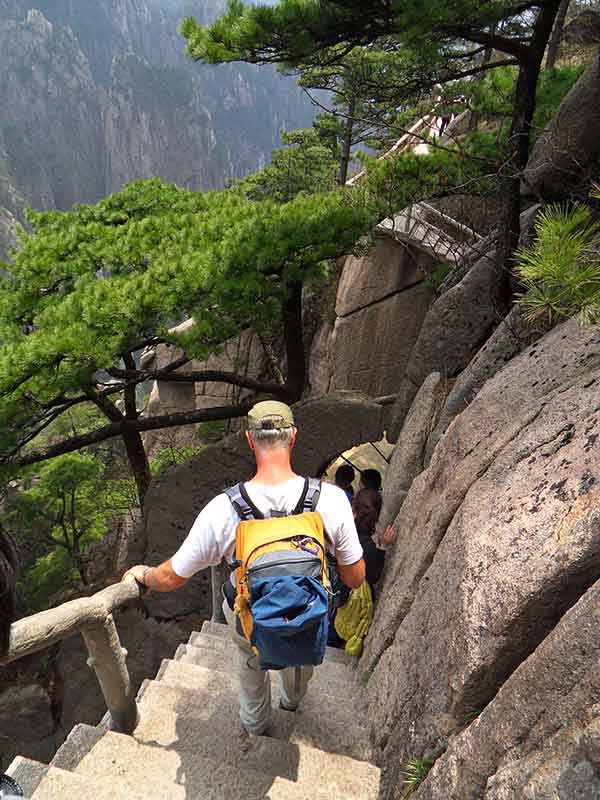 We ventured up the steep steps to Purple Cloud Peak but when we got there it was gated shut with a chain that had rusted over many months. So as not to waste the sweat and calories exhausted from the climb, we ventured off track, highly forbidden, and clambered over rocks and through woods to reach the peak. It would be a spectacular spot to watch the sun setting in the west if a great cloud hadn’t appeared to block the waning light.
We ventured up the steep steps to Purple Cloud Peak but when we got there it was gated shut with a chain that had rusted over many months. So as not to waste the sweat and calories exhausted from the climb, we ventured off track, highly forbidden, and clambered over rocks and through woods to reach the peak. It would be a spectacular spot to watch the sun setting in the west if a great cloud hadn’t appeared to block the waning light.
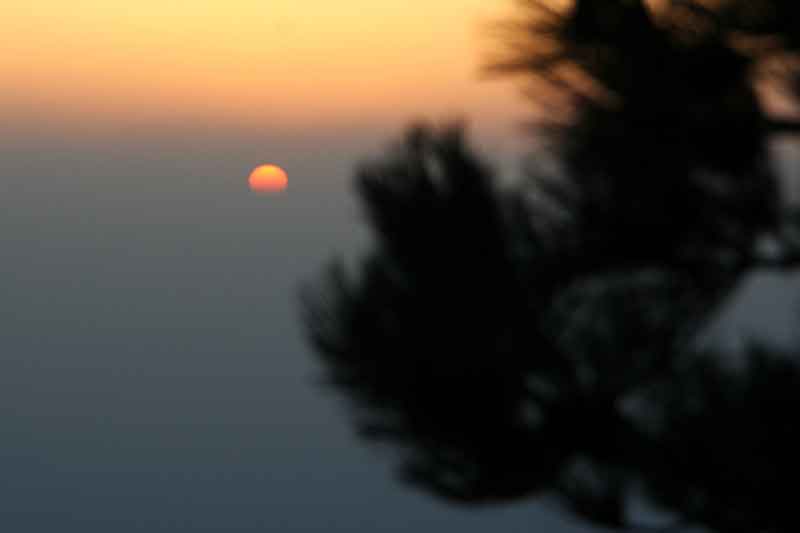 We hoped that the sunrise would compensate, and we arrived at Refreshing Terrace at 4:30am, over an hour before the sun was due to appear, to find the crowd already two deep! But we fought our way to a vantage point and awaited the great moment. We were faced with the luminous spectacle of Yunhai (literally a sea of clouds): idyllic pools of mist that settle around the base of the mountain, filling its chasms and valleys with mist, turning the peaks into islands that poke above a milky sea.
We hoped that the sunrise would compensate, and we arrived at Refreshing Terrace at 4:30am, over an hour before the sun was due to appear, to find the crowd already two deep! But we fought our way to a vantage point and awaited the great moment. We were faced with the luminous spectacle of Yunhai (literally a sea of clouds): idyllic pools of mist that settle around the base of the mountain, filling its chasms and valleys with mist, turning the peaks into islands that poke above a milky sea.
The superb views from the summit reach out across huge valleys of granite and enormous formations of rock, capped by gravity defying slivers of stone, robed by the gnarled forms of Huangshan pine trees. The scene has an unworldly, ethereal atmosphere. Then the sun begins to ascend from the mist in a dirty orange glow bathing the mountain in half light and vague shadows.
As the sun gains height it strengthens and its orange turns to yellow as the new day is announced. The rays penetrate the darkness, warming the air and lighting the rock faces that lie in its direct path while eastern facing slopes remain cloaked in grey. It’s a ten-minute spell of nature’s magic that leaves us speechless and makes all the difficulties worthwhile. What a fantastic show and how privileged we are to witness such a spectacular sunrise.
After the show is over, the entire population of the mountain descends. It’s not long before we meet the early risers on their ascent, at which point the journey becomes more stop than go. Frustration gets the better of us and we take the cable car down to find some peace and breakfast.
Just in case we might get to base at a reasonable hour, we were taken on a tedious tour of a tea factory where they tried to hard sell their produce to us in Chinese. Then we were carted to a snake factory, at which point we sat on the pavement in protest.
So the whole experience was sweet and sour. I doubt we will undertake a Chinese tour again but, we are glad we stuck it out, for Huangshan is a beautiful mountain with a view that is arrestingly spectacular and unique. Had my parents passed to me the appropriate genes, I would join the long list of Chinese artists and poets in trying to capture the aura of the mountain for posterity.

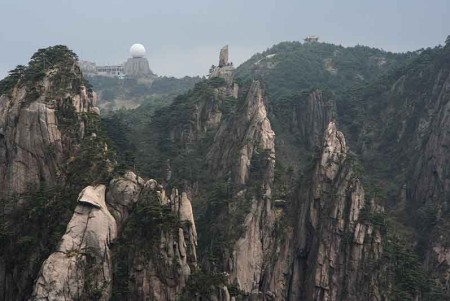
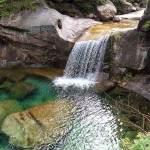
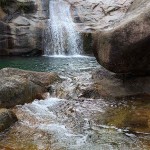
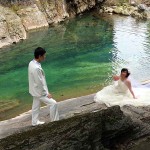
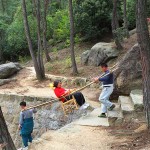
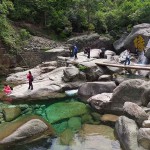
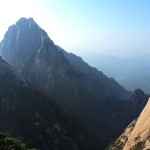
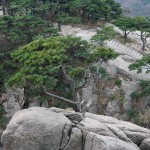
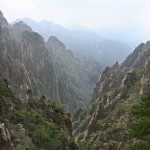
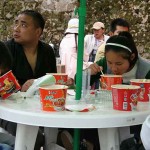
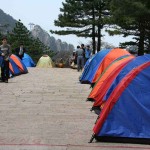
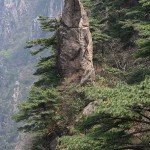
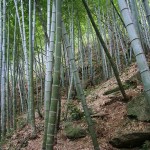
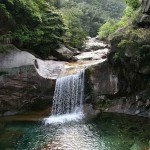
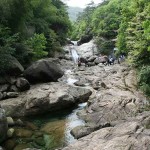
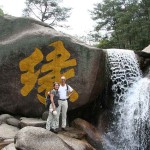
No comments yet.